The oxy-fuel combustion technology uses “oxygen plus fuel” instead of “ air plus fuel” combustion mode. This technology can save energy, reduce emission and improve melting capacity and quality of glass furnace. Based on the analysis of the oxy-fuel combustion technology and the discussion on the glass furnace problems caused by refractory material, selection and application of refractory material in the upper part of the oxy-fuel combustion glass furnace was put forward. In view of the technology feasibility of the new refractory materials developed in recent years, the concept of refractory materials consumption by melting a ton glass-melt was proposed. The main factors that affect consumption number of refractory materials by melting per ton glass-melt are summarized. Some main methods for prolonging service life of the oxy-fuel combustion glass furnace and reducing the consumption of refractory materials are also presented.
1. Oxyfuel technology
Conventional glass melting uses air as the combustion medium. When air is used as combustion aid, more than 78% of nitrogen and other components not only fail to generate heat, but also consume and take away a large amount of heat in the combustion process. The passive intervention of nitrogen not only increases energy consumption, but also generates nitrogen oxides (NOx) and other pollutants during high-temperature combustion. The combustion mode of oxyfuel technology is fuel + oxygen. With the development of oxygen technology and the reduction of electricity cost, glass furnace oxyfuel technology has excellent performance in many aspects such as environmental protection, energy saving, yield, quality, reduce equipment investment and save factory space.
Advantages of oxyfuel combustion in glass furnace:
♦ Saving fuel and improving the comprehensive efficiency of the enterprise;
♦ Able to obtain higher melting rate;
♦ It can greatly reduce the emission of nitrogen oxides (Nox) and make the flue gas treatment more convenient;
♦ Oxyfuel glass furnaces do not require direction change operation, which can effectively reduce the emission of dust and the flying of mixing materials. It can save the mixing materials and reduce the erosion of the flying dust on the top of the crown and the breast wall;
♦ It makes the adjustment of glass production process more convenient and precise;
♦ The combustion and process of glass furnace are more stable, which is conducive to increasing the rate of finished products and improving the quality of products;
♦ Reduce the consumption of refractory materials per tonne of glass to achieve the purpose of green production.
Due to the increasingly obvious advantages of oxyfuel technology applied to glass furnaces, the research and application of oxyfuel technology has been gradually launched in China, and some forward-looking and strategic enterprises and organizations are actively involved in it. With the development of economy, the problems of energy and environmental protection will be more prominent, green and circular economy are becoming the trend, and Oxyfuel technology is regarded as one of the most economical solutions.
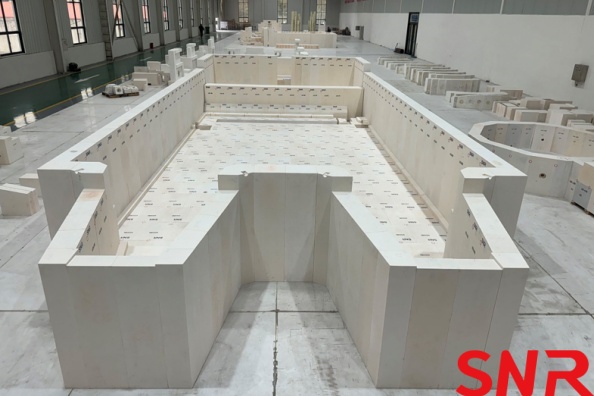
In addition to the advantages mentioned above, oxyfuel technology has a number of inherent characteristics, among which the water vapour concentration is much higher than in air-fired combustion results.
Taking natural gas as an example, the combustion process of an air-assisted glass furnace is as follows:
CH4 + xO2 +N→ CO2 + 2H2O +NOX+COX+energy
Taking natural gas as an example, the combustion process of an oxygen-assisted glass furnace is as follows:
CH4 + 2O2 → CO2 +2H2O +COX +energy
Since there is basically no introduction of nitrogen, the concentration of water vapour in the reactants of oxyfuel combustion reaches more than 50%, which is a distinctive feature of the oxyfuel combustion technology from the traditional air-assisted combustion of glass furnaces, and also has a direct impact on the structure of glass furnaces and the choice of refractory materials. As there is no nitrogen involved in the combustion, the flue gas volume is greatly reduced. Compared with the traditional air-assisted glass furnace parts of the glass furnace pressure difference becomes greater, more sensitive, oxyfuel flame is harder, shorter, radiation area is also more concentrated, the chances of local high temperature or furnace body local burns increased.
2. Characteristics of refractory materials
Refractory materials are an important part of a glass furnace. The designer of a glass furnace needs to use refractory materials to build a glass furnace structure that meets the needs of the glass melting process. This includes a suitable flame space, a melting zone, a molding zone and a structure for the venting or heat exchange of the flue gases (heat storage chamber or flue). The selection of refractory materials for glass furnaces must first fulfil the following requirements:
(1) High temperature characteristics
Glass furnace refractories materials need to have at a certain temperature of the resistance to scouring and erosion characteristics, high loading softening temperature, the main components and glass close to ensure that as far as possible not to contaminate the glass (try to reduce or do not contain ingredients that may contaminate the glass), high-temperature expansion, contraction characteristics (coefficient of expansion), anti-thermal shock resistance, and other adjacent refractory materials do not cross-react to affect the characteristics of the resistant material, and so on.
(2) Processability
The use of conventional processing equipment can process the required size and shape, minimize the use of oversized and super shaped blocks, and reduce the type and quantity of manual processing. At the same time to consider the convenience of production, assembly, packaging and transport and masonry.
(3) Economy
Minimize the usage under the condition of meeting the basic needs and choose the appropriate specifications.
(4) Systematic
Reasonable matching of refractory specifications and quantities in different parts, as far as possible to achieve the same life of the glass furnace refractory materials and the glass furnace. According to the application experience, after the traditional air-assisted combustion glass furnace is changed to oxy-fuel glass furnace, there is no great change in the selection of refractory materials for the lower structure, which mainly focuses on the selection and use of refractory materials for the upper space.


3. Oxyfuel glass furnace refractory application of the problems easily produced
3.1 Deformation of the crown
Oxyfuel glass furnaces, whether made of electro fused cast AZS block or bonded materials, have had cases of crown deformation, which may lead to production stoppage and repair, or direct collapse in severe cases. According to the known oxygen-fired glass furnace failure statistics, there have been a number of glass furnaces similar to the deformation of the crown, the collapse of the situation, which not only relates to the life of the glass furnace, the cost, the quality of the glass, but also affects the success or failure of the entire project.
The deformation of the crown is commonly referred to as saddle or M-shaped deformation, which can be divided into parallel and perpendicular along the axis of the glass furnace. The deformation usually occurs in the higher temperature zone. Figure 1 shows an example of a crown deformation.
Deformation is usually the result of the selection of materials with substandard load softening temperatures, or due to localized combustion temperatures exceeding the rated load softening temperatures of the selected materials, but also accidents caused by substandard masonry.
3.2 Breast wall collapse
These years, oxy-fuel glass furnace has also occurred in the breast wall partial or overall collapse of the incident, which is not only on the glass furnace design unit in the choice of materials and masonry requirements, but also on the use of glass furnaces and process control party put forward new requirements.
3.3 Localized burns
Mainly occurs in the vicinity of the burner block or the opposite position of the burner gun. The flame temperature of oxyfuel combustion is higher, the impact is stronger, and the pressure inside the glass furnace is higher during combustion, which is easy to affect the lining of the glass furnace and the glass liquid level. Proper operation and spot checks can reduce or prevent localized burnout.
3.4 Leakage
Oxyfuel glass furnace has occurred in the side wall perforation leakage accident, the cause of the accident includes both refractory quality problems, but also involves the enterprise point inspection is not in place and the low level of day-to-day control and other factors.
4. Refractory material selection principles
This paper discusses the issue of oxyfuel refractory materials mainly for the refractory materials inside the glass furnace. Traditional air-fuelled glass furnace flame space refractory materials are generally based on silica materials, the use of electrofusion or other refractory materials commonly used in special glass furnaces. Glass furnace using oxyfuel technology, due to the flame space in the volume concentration of water vapour increases greatly, the volume concentration of alkali volatiles increased by 3 to 6 times. Conventional air-assisted combustion glass furnace upper space more cases will use siliceous materials, high concentration of water vapour and high concentration of alkali volatiles to form a strong alkaline atmosphere, the use of silica bricks in the upper structure of the performance of harm.
SiO2+2NaOH+O2→ Na2SiO4+H2O
The concentration of alkali vapours is slightly lower in the breast wall and the gable wall than in the crown, but they are also exposed to the reaction of acid-base neutralisation, which makes the life of the glass furnace unpredictable at a rate that exceeds the normal rate of erosion. In addition, the material flaked off by erosion falls onto the glass surface and forms slag, which further affects the melting performance and glass quality.
4.1 Factors to be considered in the selection of refractory materials
In the principle of refractory selection, in addition to high temperature resistance, processability, economy, systematic, etc., should also be based on the characteristics of oxyfuel refractory selection. Both fused cast AZS blocks and fused alumina products have accumulated rich successful experience in China‘s domestic oxyfuel glass furnaces. According to the characteristics of the glass furnace and the different characteristics of the product, there are also cases of using other refractory materials in China.
At present, the refractories used in the upper structure of oxy-fuel glass furnace are mainly fused materials, such as fused cast AZS series, fused alumina series, fused chrome corundum series (currently there is a trend to use sintered chrome corundum instead of), etc. In the fused AZS series, the refractories used in the upper structure of glass furnace are mainly sintered chrome corundum and sintered chrome corundum. In the fused AZS series, the common ones are fused cast AZS 33#block, fused cast AZS 36#block, fused cast AZS 41#block, and the fused alumina series includes fused α-β
alumina and fused β-alumina materials.
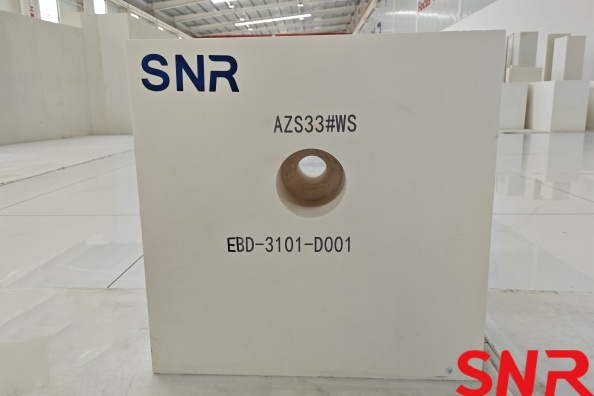

4.2 fused cast AZS blocks series



|
Item |
AZS33 |
AZS36 |
AZS41 |
|
|
|
Al2O3 |
≥47%-50% |
≥46.5-49.5 |
≥43-46 |
|
ZrO2 |
≥32.50 |
≥35.50 |
≥40.50 |
|
|
SiO2 |
≤15.00 |
≤13.50 |
≤12 |
|
|
Na2O+K2O |
≤1.50 |
≤1.4 |
≤1.50 |
|
|
Fe2O3+TiO2 +CaO |
≤0.25 |
|
|
|
|
Volume density g/cm3 |
|
≥3.8-3.9 |
≥4.00 |
|
|
Apparent Porosity % |
≤1.2 |
≤1.0 |
≤1.2 |
|
|
Cold Crushing Strength Mpa |
≥200 |
≥200 |
≥200 |
|
|
Exudation Temperature of Glass Phase |
≥1400 |
≥1400 |
≥1410 |
|
|
Bubble Separation Ratio(1300℃×10h) |
≤1.2 |
≤1.0 |
≤1.0 |
|
|
Anti-corrosion rate of glass liquid 1500℃×36h (mm/24h)% |
≤1.5 |
≤1.3 |
≤1.2 |
|
|
Bulk density(g/cm3) |
PT(RN RC N) |
≥3.45-3.5 |
|
|
|
ZWS |
≥3.65-3.7 |
≥3.80-3.85 |
≥3.85-3.9 |
|
|
WS |
≥3.7-3.75 |
≥3.85-3.9 |
≥3.95-4.0 |
|
4.3 High-zirconium series refractories
High zirconium series products usually refer to the zirconium oxide content of 85% to 95% of the product. Although its production is more difficult, the price is higher. But because of its superior performance and has a wide range of applications in many glass industries. Typical chemical composition and crystallographic analysis of high zirconia refractories are shown in Figure 3.
Fig. 3 Typical chemical composition and crystal phase analysis of high zirconium series refractories
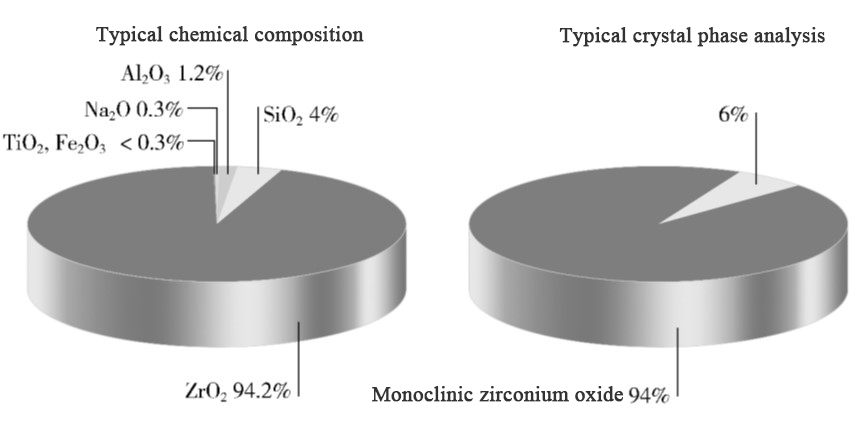
Due to its excellent properties, it reduces the production of stones and air bubbles in glass production, and is therefore more suitable for use in glass furnaces where it comes into contact with the glass, and has good performance in the glass furnaces for borosilicate glass, alumina-silicate glass, glass ceramics and display glass. Depending on the requirements, there is also a subdivision for high resistivity.
4.4 fused α-β alumina products
By each about 50% of α- alumina and β- alumina composition, the two crystalline interlaced to form a very dense tissue structure, alkali resistance is very good, in 1350 ℃ has a very good erosion resistance. Because of the absence of iron, titanium and other harmful impurities, the glass phase content is very small, and its flaking material on the glass pollution is minimal. In addition to common applications such as distributor channels, clarifiers and lip blocks of float glass furnaces, it can also be used as top pf crown of glass furnaces (mainly considering the longer life and the contamination of the glass liquid by suspended liquid droplets).
4.5 Electro fused β-alumina products
Composed of 100% β-alumina, there are large plate-like β-alumina crystalline organization, interlocking crystals and the crystal phase is very coarse, high porosity, low strength. However, the resistance to spalling is very good, especially for strong alkali vapour with high erosion resistance. Due to the reaction with silica β-alumina is easy to α- alumina and sodium oxide is more prone to cracking, so it must be used in the part of the dust flying lighter, as a glass furnace crown is generally used in the back end.
Electro fused α-β or β-alumina products have been used in domestic glass furnaces have shown excellent resistance to erosion and little contamination of the glass properties, the application is very good. Higher prices are the biggest obstacle to their widespread use.
4.6 Bonded a-b alumina products
Bonded a-b alumina products are relatively inexpensive and have been successfully used in domestic glass furnaces in recent years. Because of its special composition, it has become a better choice for low and medium temperature channels. With the progress of technology, domestic similar sintered materials have also been listed, and achieved better results. Smaller glass furnaces or where the requirement for crown drop contamination from top of crown formation is not very high, it can be considered as a tip of crown material.
4.7 Application of new refractory materials
4.7.1 High purity magnesium aluminum spinel
The chemical formula of magnesium aluminum spinel is MgO-Al2O3, containing 28.3% MgO and 71.7% Al2O3 (atypical data, for reference only). Its main advantages are strong corrosion resistance to reducing atmospheres such as free CO2, free SOX and free K2O/Na2O, good thermal stability and wear resistance. Magnesium-aluminum spinel has a high melting point, low coefficient of thermal expansion, low thermal stress, good thermal shock stability, low bulk density (2.7 g/cm3) compared to electro fusion materials, and strong resistance to alkaline atmospheres.
In the domestic air-fuelled and oxy-fuel glass furnaces there are actual cases of magnesium-aluminum spinel, but most of them have the problem of crown saddle-shaped deformation.
4.7.2 Isostatically molded high zirconium bricks
Isostatically molded high zirconium bricks have been used in oxy-fuel glass furnaces with good applications due to their excellent densification, erosion resistance and lower price compared to electro fused high zirconium bricks.
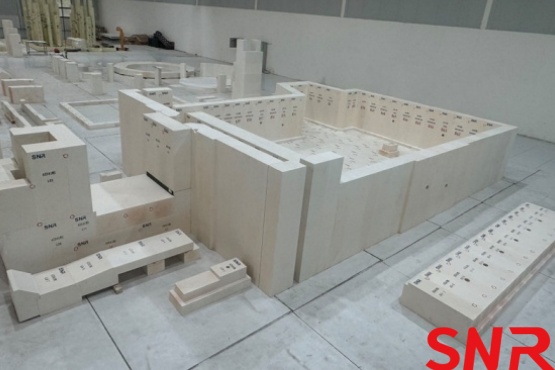
4.7.3 Dense chrome oxide bricks
Dense chromium oxide bricks have been widely used in glass furnaces due to their excellent thermal shock properties, alkali resistance, and scour resistance, and also in the flame space of oxy-fuel glass furnaces. The chromium in dense chromium bricks adopts different chromium contents according to different parts of use, generally CrO >90%, bulk weight >4.0 g/cm3.
At present, in addition to foreign and joint venture production, many domestic enterprises can provide the same products, but the quality and physicochemical stability varies greatly. The pollution problem of chromium is more difficult to solve, and many European countries have numerous restrictions on the production and application of chromium-containing products. Chromium oxide has strong coloring ability, generally high white material or higher quality glass is not recommended to use chromium-containing resistant material, especially the parts in contact with glass liquid. For color glass or lower quality green and white materials, the use of chromium oxide can be considered to extend the life of the glass furnace.
4.7.4 Electro fused re-bonded mullite
Typical product data for electro fused re-bonded mullite bricks are: Al2O376%, Fe2O3 0.1%, SiO2 23%. Load softening temperature T >1,700 °C, bulk density 2.66 g/cm3, compressive strength at normal temperature 1,100 N/mm2, glass phase content <4%. Because of its relatively neutral qualities, it is currently used more often in the crown of oxy-fuel glass furnaces.
4.7.5 Calcium-free silica bricks
The advantages of this product are:
① It uses fused silica bonding phase, does not contain calcium oxide, and the silica content can reach more than 98.5%;
② The density is lower (1.8 g/cm3), which reduces the weight of the entire crown;
③ The price is lower than that of the same level of fused materials;
④ It has a lower expansion coefficient (0.6% at 650 ℃) and a higher operating temperature (T0.5 is 1 690 ℃) than silica bricks;
⑤ Better volume stability. It has been used in a domestic all-oxygen combustion glass furnace, but the crown has deformation problems that threaten the safety of the glass furnace.
5. Consumption of refractory materials per ton of glass
Consumption of refractory materials per ton of glass refers to the ratio of the amount of glass discharged during a glass furnace life to the number of refractory materials used in this glass furnace, and the unit is kg/t glass. It is a comprehensive indicator reflecting the advancement of glass furnaces and glass production. At present, the data of domestic glass furnaces still have a large gap compared with the level of the same industry in Germany and Japan, which is mainly reflected in the life and discharge of glass furnaces. Table 5 is a comparison of the data of domestic and Japanese air-assisted combustion glass furnaces.
Table 5 Comparison of domestic and Japanese air-assisted glass furnace data
|
|
200 tons bottle and jar glass furnace (normal soda-lime) |
|
|
Air-assisted combustion (domestic) |
Air-assisted combustion (Japan) |
|
|
Melting area/m2 |
75 |
60 |
|
Melting rate/t·d-1·m-2 |
2.55 |
3.33 |
|
Crushed glass rate/% |
45 |
68 |
|
Daily output/t·d-1 |
191 |
200 |
|
Glass furnace life/year |
4.5 |
9 |
|
Total material output/t |
31.37 |
65.70 |
|
Refractory consumption/t |
1885 |
1406 |
|
Consumption of refractory material per tons of glass/kg·t -1 |
6.01 |
2.14 |
Oxyfuel glass furnaces use considerably less refractory material due to the absence of a regenerator. Table 6 shows a comparison of the data for air-assisted glass furnaces and oxyfuel glass furnaces.
Table 6 Comparison of data for air-assisted glass furnaces and oxy-fuel glass furnaces
|
|
100 tons bottle and jar glass furnace (high white material) |
|
|
air-assisted combustion |
oxyfuel combustion |
|
|
Melting area/m2 |
70 |
55 |
|
Melting rate/t·d-1·m-2 |
1.43 |
1.82 |
|
Crushed glass rate/% |
12 |
10 |
|
Daily output/t·d-1 |
100 |
100 |
|
Glass furnace life/year |
4 |
5 |
|
Total material output/t |
14.6 |
18.25 |
|
Refractory consumption/t |
1865 |
724 |
|
Consumption of refractory material per tons of glass/kg·t -1 |
12.77 |
3.97 |
Note: As it is difficult to find exactly close glass furnaces for comparison, the comparative data is for reference only.
5.1 Main factors affecting tons of glass resist consumption
The main factors affecting the consumption of tons of glass refractory:
① The life of the glass furnace and the total amount of material discharged is related to the quality of the selected refractory material and the level of production control;
② Different categories of glass furnace refractory consumption is different, a comprehensive comparison, the traditional regenerator glass furnace refractory consumption is large.
5.2 The main methods to extend the life of glass furnace and reduce the use of refractory material
1. Reasonable selection of refractory materials. Select refractory materials in line with the specifications, in different parts of the need to choose the appropriate refractory materials.
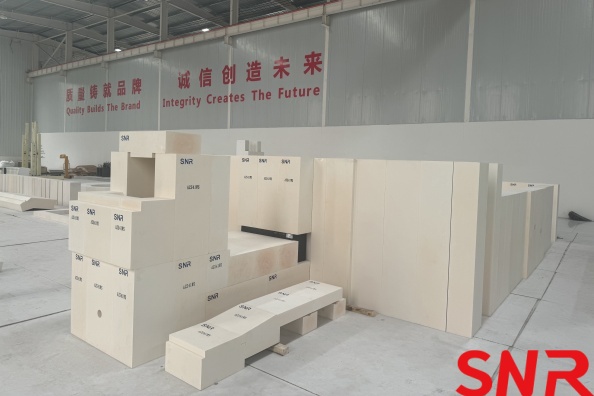

2. Masonry and construction. Comply with the standard construction process, reasonable heating and heat treatment.
3. Reasonable design of glass furnace feeding volume. Scientifically coordinate the interrelationship of glass furnace life, energy consumption, production and quality, and gradually find out a scientific, reasonable and efficient balanced relationship according to its own characteristics.
4. Process control level. Reduce the habit of high-temperature forced melting and high glass furnace pressure production for the purpose of increasing the output quantity and reducing energy consumption. Enhance the management of mixing materials, the control of material output, the analysis of factors affecting glass quality, and gradually form a benign self-correcting mechanism.
5. Site management level. Strengthen the point inspection of glass furnace, data accumulation, and the importance of thermal protection work.
6. Gradually increase the use of oxyfuel technology in the glass industry and reduce the consumption of refractory materials.
The glass industry, especially in the field of daily-use glass, is very different, with great differences in product structure and low comparability, making it difficult to unify the standards. It is the necessary way to enhance economic efficiency, energy saving and emission reduction to gradually improve the life of glass furnace, improve product quality and reduce the consumption of refractory material per ton of glass furnace by constantly exploring the application of new technology, new products and new techniques.
6.Conclusion
After more than ten years of development, oxy-fuel glass furnace has formed a set of more mature system in the selection and use of refractory materials. Through the industry insightful people‘s search for innovation, more new refractory use methods and types of refractory materials continue to enrich the oxygen-fired glass furnace industry, to enrich the connotation of the field of oxyfuel technology has played a positive role.
For the selection of refractory materials, you can refer to 4.1 Factors to be considered in the selection of refractory materials. I recommend the use of fused cast AZS blocks. Henan SNR Refractory Co., Ltd. is dedicated to the manufacturing research and development of fused cast AZS refractory materials for the glass industry. Meanwhile, SNR can provide total solutions and services for glass furnace design, glass furnace construction, renovation, and upgrading. Please contact me if you have any requirements.
CONTACT: zoe@snrefractory.com
WEBSITE: www.snr-azs.com



